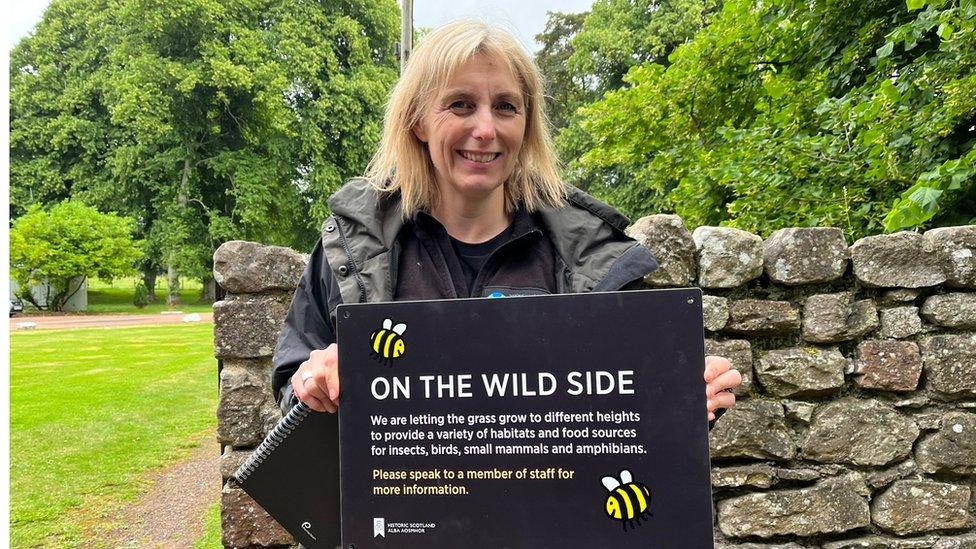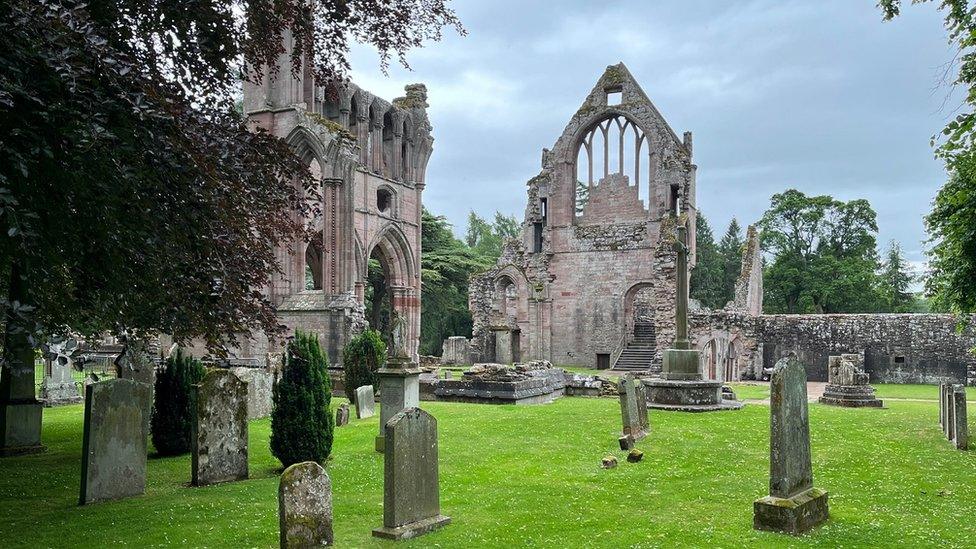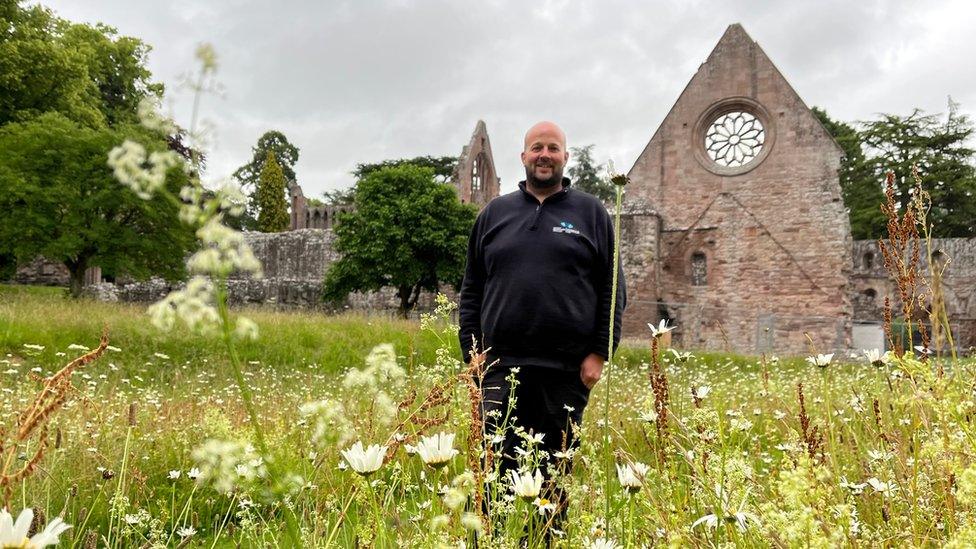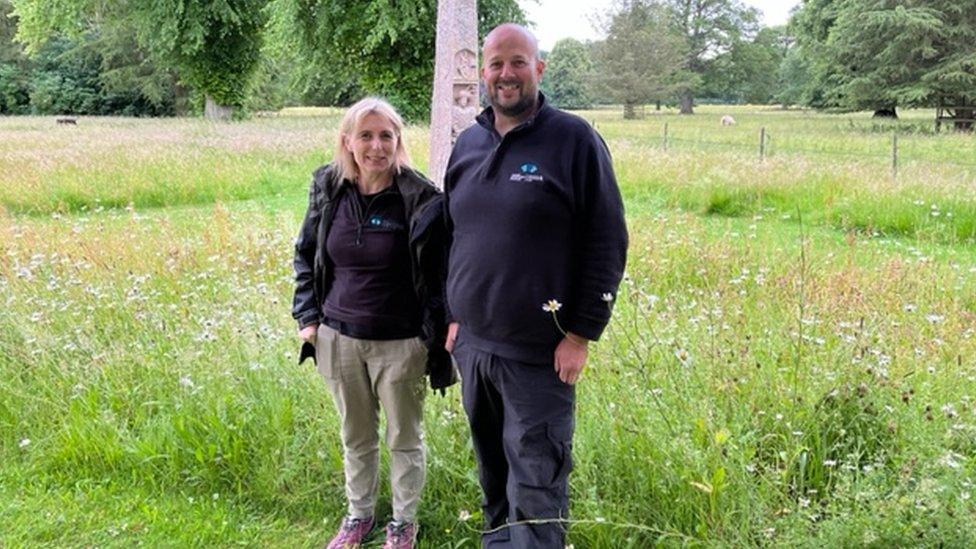Dryburgh Abbey's Romantic notion leads to biodiversity blueprint
- Published

Sarah Franklin believes Dryburgh is leading the way in tackling the biodiversity and climate change crises.
A Romantic notion has led to a Borders abbey leading the way in tackling the biodiversity crisis.
Managers and gardeners at Dryburgh wanted to recreate an early 19th Century landscape when they published their plans six years ago.
Now the flowering meadows are acting as a blueprint for other Historic Environment Scotland (HES) sites.
Landscape manager Sarah Franklin said: "The changes in such a short space of time are spectacular."
As with most of the country's historic attractions, visitors arriving at Dryburgh Abbey were welcomed by carefully manicured lawns and well-maintained flower beds.
But plans for a change were hatched in 2016, with Ms Franklin looking to recreate the same grounds that drew Romantic writers and artists, such as Sir Walter Scott and JMW Turner, to the ruins.
Within a year, areas for wild grasses and flowers were mapped out and work began to return to a more natural environment.

Sarah Franklin with new signs which are being erected around Dryburgh Abbey
Sarah explained: "We looked deeply into the history of the abbey when creating our landscape management plan, and the Romanticism of the abbey, with all of its associations with poets, writers and artists of that era, seemed the obvious choice.
"We realised when we started that there are distinct parallels between then and now, as there was a lot of political instability then with the Napoleonic wars and industrialisation and people were looking to nature to get some spiritualisation and wellbeing.
"Now, post-Covid, with a biodiversity crisis and climate change crisis we're looking at nature once more to reset the balance.
"What is essentially us recreating the Romantic period with our landscape, is proving to also be good for biodiversity with an abundance of pollinators enjoying the new areas."
Dryburgh Abbey, on the banks of the River Tweed, was founded in the 12th Century by priests from Alnwick Abbey in Northumberland.
Frequently damaged during cross-border wars, the chapel, cloisters and chapterhouse were reduced to ruins during the Reformation.
David Erskine, the 11th Earl of Buchan, is credited with preserving what remains today of the abbey after buying the land in the late 18th Century, leading to many noted writers, poets and painters taking inspiration from its setting and its history.

Dryburgh Abbey dates from the 12th Century
Mark Gillie, who has been head gardener at Dryburgh for the past 13 years, was charged with transforming lawns back into the natural habitats of the early 1800s.
He said: "It was 2017 when we first started to move away from the manicured lawns you usually associate with the places like Dryburgh Abbey.
"We now have many natural growing areas, and in around a third of them we have introduced wildflower seeds.
"Just within one small patch you can see daisies, yellow rattle, yarrow, orchids and many more - and you can also see the insects which need them.
"The feedback from visitors has been mainly positive, although you do get some people who prefer striped lawns."

Head gardener Mark Gillie hopes to recreate wild flower areas at other historic sites in the Borders
HES is only using Scottish-sourced wildflower seeds for their growth and blooming to coincide with the needs of local pollinators.
Other sites in the Borders, including Melrose Abbey, the Cross Kirk in Peebles, and Jedburgh Abbey, will be following Dryburgh's wildflower lead in the summers to come.
And it is hoped that other historic attractions across Scotland will also be blooming in the near future.

Sarah Franklin and Mark Gillie are delighted with the wild flower areas at Dryburgh
Sarah added: "We will be taking this forward, although some sites have sensitive archaeology and that can make life difficult for establishing wildflower meadows.
"We can't just lift the turf and scatter seeds around many historic buildings, but we will be looking to recreate what we have here at Dryburgh on sites where we can."